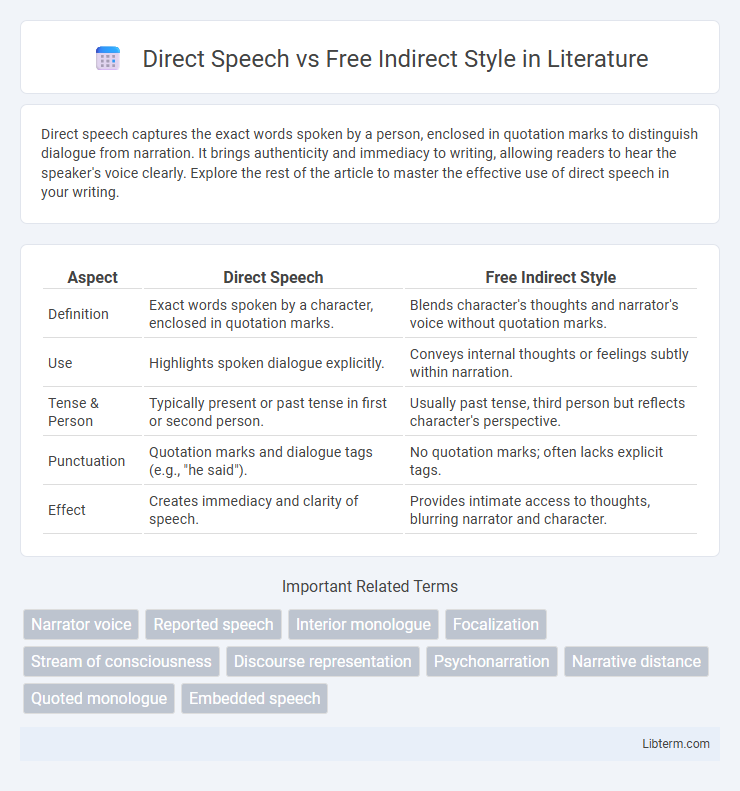Direct speech captures the exact words spoken by a person, enclosed in quotation marks to distinguish dialogue from narration. It brings authenticity and immediacy to writing, allowing readers to hear the speaker's voice clearly. Explore the rest of the article to master the effective use of direct speech in your writing.
Table of Comparison
| Aspect | Direct Speech | Free Indirect Style |
|---|---|---|
| Definition | Exact words spoken by a character, enclosed in quotation marks. | Blends character's thoughts and narrator's voice without quotation marks. |
| Use | Highlights spoken dialogue explicitly. | Conveys internal thoughts or feelings subtly within narration. |
| Tense & Person | Typically present or past tense in first or second person. | Usually past tense, third person but reflects character's perspective. |
| Punctuation | Quotation marks and dialogue tags (e.g., "he said"). | No quotation marks; often lacks explicit tags. |
| Effect | Creates immediacy and clarity of speech. | Provides intimate access to thoughts, blurring narrator and character. |
Understanding Direct Speech
Direct speech represents a character's exact words within quotation marks, preserving their unique voice, tone, and emotions. It facilitates immediate reader engagement by creating a vivid, dynamic interaction that conveys personality and intention. This style is crucial for authentic dialogue, allowing readers to experience conversations as they unfold in real time.
Defining Free Indirect Style
Free indirect style blends characters' thoughts and speech into the third-person narrative, eliminating the need for quotation marks or explicit attributions found in direct speech. This technique captures subjective experiences and internal reflections while maintaining narrative distance, offering a fluid and nuanced portrayal of consciousness. Frequently employed in modernist literature, free indirect style enhances psychological depth and immediacy without interrupting the flow of the story.
Key Features of Direct Speech
Direct speech captures the exact words spoken by a character, enclosed in quotation marks to indicate dialogue. It uses first-person pronouns and present tense verbs, preserving the speaker's original tone, emotion, and style. Key features include clear attribution tags such as "he said" or "she asked" and punctuation that separates speech from narration.
Hallmarks of Free Indirect Style
Free Indirect Style blurs the boundary between the narrator's voice and a character's thoughts or speech, creating a seamless blend without quotation marks or explicit attribution. Hallmarks include the use of third-person narration infused with the character's subjective tone, vocabulary, and emotional nuances, often capturing internal monologues or perceptions. This style enables readers to experience a character's perspective more intimately while maintaining the narrative's external viewpoint.
Narrative Voice and Point of View
Direct speech presents characters' exact words, maintaining a clear distinction between narrator and character voices, which preserves the narrator's external point of view. Free indirect style blends characters' thoughts and speech seamlessly into the narrative, creating a fluid merger of narrative voice and character perspective that often reflects a third-person limited point of view. This technique allows the narrator to adopt the character's subjective experience without quotation marks, enhancing psychological depth and immediacy in storytelling.
Emotional Impact and Reader Engagement
Direct speech delivers raw emotional impact by presenting characters' exact words, creating immediacy and intimacy that draws readers deeply into the scene. Free indirect style blends a character's thoughts and feelings with the narrator's voice, offering nuanced emotional depth while maintaining narrative flow and subtlety. This hybrid approach enhances reader engagement by allowing insight into internal states without breaking the story's immersive rhythm.
Syntax and Punctuation Differences
Direct speech features explicit quotation marks and a clear speaker attribution, maintaining the original sentence structure and punctuation to preserve the exact words spoken. Free indirect style blends the narrator's voice with the character's thoughts or speech, eliminating quotation marks and often altering syntax to merge subjective experience with narrative flow. Punctuation in free indirect style is more fluid, frequently using commas or no markers where direct speech would require quotes and dialogue tags.
Common Uses in Literature
Direct speech clearly presents a character's exact words within quotation marks, enhancing immediacy and authenticity in dialogue-heavy scenes. Free indirect style blends the narrator's voice with characters' thoughts and feelings, providing intimate access to consciousness without explicit quotation. Commonly, direct speech drives plot through explicit conversations, while free indirect style deepens characterization and psychological insight in literary narratives.
Strengths and Limitations of Each Style
Direct speech provides clear and vivid character voice by presenting dialogue verbatim, enhancing immediacy and reader engagement but may disrupt narrative flow or limit authorial commentary. Free indirect style blends character thoughts and narration seamlessly, offering deep psychological insight and smoother transitions, though it can cause ambiguity in distinguishing narrator from character perspectives. Both styles serve different narrative purposes, with direct speech excelling in dynamic interaction and free indirect style excelling in nuanced introspection.
Choosing the Appropriate Style for Your Writing
Choosing between direct speech and free indirect style depends on the narrative focus and desired reader engagement. Direct speech provides clear, explicit dialogue that reveals characters' exact words and emotions, ideal for emphasizing immediate interactions. Free indirect style blends the narrator's voice with a character's thoughts, offering subtle insight and maintaining narrative flow without breaking into quoted dialogue.
Direct Speech Infographic

 libterm.com
libterm.com